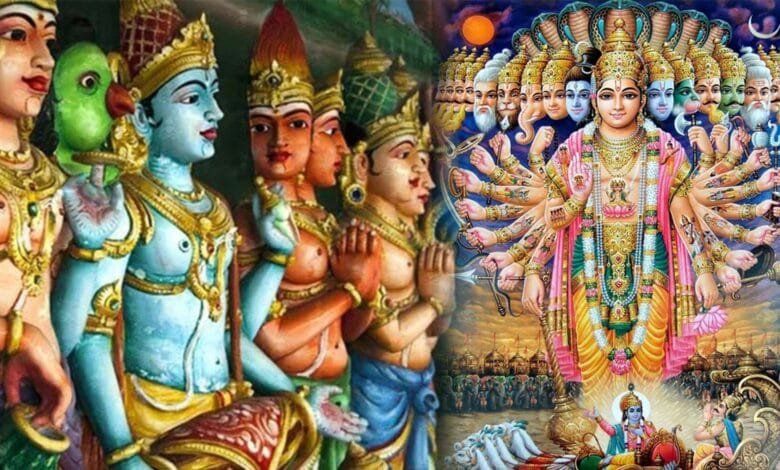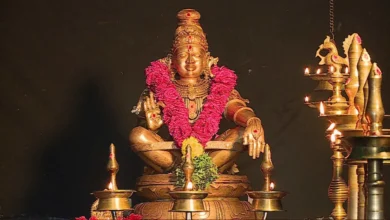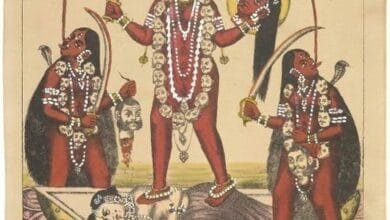33 Crore or 33 Koti Gods? The Amazing Truth Revealed

33 Koti Gods not 33 Crore: Have you ever heard someone say that Hinduism has 33 crore (330 million) gods? This is one of the most common misunderstandings about Hindu mythology. Today, we’re going to clear up this confusion once and for all.
The Big Misunderstanding: Crore vs Koti
The confusion starts with one simple word: Koti.
In modern Hindi, “koti” means crore (10 million). But in ancient Sanskrit, the same word “koti” has a completely different meaning – it means “type” or “category”.
So when ancient Hindu texts mention “33 koti devi devta,” they’re not talking about 330 million gods. They’re actually referring to 33 types or categories of divine beings.
What Does 33 Koti Ka Matlab Actually Mean?
Let’s break this down:
- 33 Koti = 33 Types/Categories
- Devi Devta = Gods and Goddesses
The ancient Vedic texts, particularly the Rigveda and other scriptures, classify divine beings into 33 specific groups. This classification helps organize the complex spiritual hierarchy in Hindu philosophy.

The 33 Categories of Hindu Deities
According to the Vedas, these 33 types of divine beings are divided into several groups:
The Main Classification
1. The 12 Adityas (Solar Deities) These are the twelve forms of the Sun God representing different months:
- Dhata
- Mitra
- Aryaman
- Shakra
- Varuna
- Amsha
- Bhaga
- Vivasvan
- Pusha
- Savita
- Tvastra
- Vishnu
2. The 8 Vasus (Elemental Gods) These represent natural elements:
- Prithvi (Earth)
- Agni (Fire)
- Antariksha (Atmosphere)
- Vayu (Wind)
- Dyaus (Sky)
- Aditya (Sun)
- Nakshatra (Stars)
- Soma (Moon)
3. The 11 Rudras (Forms of Lord Shiva) These are manifestations of destructive and transformative power:
- Manyu
- Manu
- Mahmasa
- Mahan
- Shiva
- Ritudvaj
- Ugraretas
- Bhava
- Kama
- Vamadeva
- Dhritavrata
4. The 2 Ashvins (Divine Physicians) These are the celestial healers:
- Nasatya
- Dasra
5. Indra (The King of Gods) The ruler of heaven and god of rain and thunderstorms.
6. Prajapati (Lord of Creatures) The creator deity, often identified with Brahma.
Total: 12 + 8 + 11 + 2 = 33 Divine Categories
33 Koti Gods not 33 Crore: Why This Matters
Understanding that Hinduism speaks of 33 types rather than 33 crore gods changes everything:
- Hinduism is not polytheistic in the way many think – It has an organized spiritual hierarchy
- The concept is philosophical – These categories represent different aspects of the divine and nature
- Unity in diversity – Most Hindu philosophies believe all these forms ultimately represent one supreme reality (Brahman)
The One Supreme Reality
While there are 33 categories of deities, Hindu philosophy teaches that all divine forms are ultimately manifestations of one supreme consciousness. This is beautifully expressed in the concept:
“Ekam Sat Vipra Bahudha Vadanti” – Truth is one, the wise call it by many names.
The various gods and goddesses are like different windows through which people can connect with the divine, depending on their nature, needs, and understanding.
Common Questions Answered
Q: Does Hinduism really worship 330 million gods? No, this is a mistranslation. The texts refer to 33 types or categories of divine beings.
Q: What is the meaning of “koti” in this context? In ancient Sanskrit, “koti” means “type” or “category,” not “crore” (10 million).
Q: Are all Hindu gods equal? In Vedic classification, they have different roles and hierarchies. However, many Hindus believe they are all aspects of one supreme reality.
Q: Who are the main gods among the 33 koti? The major deities include the Trimurti (Brahma, Vishnu, Shiva), along with goddesses like Lakshmi, Saraswati, and Parvati, who represent various aspects of the divine.
The Beauty of This Understanding
When we understand that Hinduism speaks of 33 types rather than millions of gods, we see the sophisticated philosophical system behind it. Each category represents:
- Different aspects of nature
- Various human needs and aspirations
- Different paths to spiritual growth
- The infinite expressions of one divine reality
Conclusion
The next time someone asks you about the 33 crore gods in Hinduism, you can confidently explain the real meaning. It’s not about worshipping millions of separate gods. It’s about understanding that the divine expresses itself in countless ways, organized into 33 beautiful categories.
This ancient wisdom shows us that Hinduism is not about superstition or mindless worship of countless deities. It’s a sophisticated spiritual philosophy that recognizes the divine in all aspects of existence while maintaining that all paths lead to the same ultimate truth.
The confusion between “koti” as type versus crore has led to many misunderstandings, but now you know the truth. Share this knowledge and help others understand the real beauty of Hindu philosophy.
Follow us on x.com
Discover more from Sanatan Roots
Subscribe to get the latest posts sent to your email.


